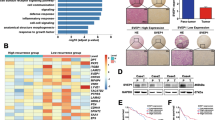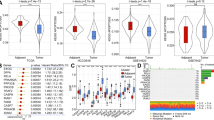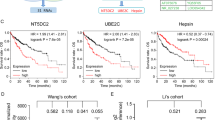Abstract
Vascular invasion is one of the clinicopathologic features that are associated with early recurrence of human hepatocellular carcinoma (HCC). In this study, we have employed high-density Affymetrix oligonucleotide GeneChips (Affymetrix, Santa Clara, CA) to compare the expression profiles of HCC with and without vascular invasion. Data mining of the gene expression database established revealed that leukocyte cell-derived chemotaxin-2 (LECT2) transcripts were downregulated in HCC patients with vascular invasion. Expression of LECT2 in human HCC biopsies was significantly reduced (P<0.0001, fold change=−7.2) when compared with non-tumorous adjacent liver tissues. The reduction of LECT2 expression was significantly correlated with the early recurrent and poor prognosis of the patient (P=0.024). To validate the ability of LECT2 to repress the growth of HCC, an adenoviral vector encoding the secreted human LECT2 (AdLECT2) was introduced into the human HCC cell lines Hep3B and PLC/PRF/5, which do not express endogenous LECT2. Over-expression of LECT2 resulted in the significant inhibition of in vitro migration and invasion of the AdLECT2-transfected HCC cells. Additionally, over-expression of AdLECT2 in subcutaneous Hep3B tumor xenografts in athymic nude mice resulted in significant inhibition of tumor growth (P<0.05). In summary, our data not only demonstrated that LECT2 is a candidate prognostic marker of human HCC, but also that therapeutic strategies targeting LECT2 expression is a promising therapy for human HCC.
This is a preview of subscription content, access via your institution
Access options
Subscribe to this journal
Receive 12 print issues and online access
$259.00 per year
only $21.58 per issue
Buy this article
- Purchase on Springer Link
- Instant access to full article PDF
Prices may be subject to local taxes which are calculated during checkout







Similar content being viewed by others
References
Hui KM . Human hepatocellular carcinoma: expression profiles-based molecular interpretations and clinical applications. Cancer Lett 2009; 286: 96–102.
Llovet JM, Bru C, Bruix J . Prognosis of hepatocellular carcinoma: the BCLC staging classification. Semin Liver Dis 1999; 19: 329–338.
Mann CD, Neal CP, Garcea G, Manson MM, Dennison AR, Berry DP . Prognostic molecular markers in hepatocellular carcinoma: a systematic review. Eur J Cancer 2007; 43: 979–992.
Lau WY, Lai EC . Hepatocellular carcinoma: current management and recent advances. Hepatobiliary Pancreat Dis Int 2008; 7: 237–257.
Llovet JM, Burroughs A, Bruix J . Hepatocellular carcinoma. Lancet 2003; 362: 1907–1917.
Schiffman SC, Woodall CE, Kooby DA, Martin RC, Staley CA, Egnatashvili V et al. Factors associated with recurrence and survival following hepatectomy for large hepatocellular carcinoma: a multicenter analysis. J Surg Oncol 2010; 101: 105–110.
Thuerigen O, Schneeweiss A, Toedt G, Warnat P, Hahn M, Kramer H et al. Gene expression signature predicting pathologic complete response with gemcitabine, epirubicin, and docetaxel in primary breast cancer. J Clin Oncol 2006; 24: 1839–1845.
Tsai TJ, Chau GY, Lui WY, Tsay SH, King KL, Loong CC et al. Clinical significance of microscopic tumor venous invasion in patients with resectable hepatocellular carcinoma. Surgery 2000; 127: 603–608.
Wang SM, Ooi LL, Hui KM . Identification and validation of a novel gene signature associated with the recurrence of human hepatocellular carcinoma. Clin Cancer Res 2007; 13: 6275–6283.
Zhou YM, Yang JM, Li B, Yin ZF, Xu F, Wang B et al. Risk factors for early recurrence of small hepatocellular carcinoma after curative resection. Hepatobiliary Pancreat Dis Int 2010; 9: 33–37.
Kameoka Y, Yamagoe S, Hatano Y, Kasama T, Suzuki K . Val58Ile polymorphism of the neutrophil chemoattractant LECT2 and rheumatoid arthritis in the Japanese population. Arthritis Rheum 2000; 43: 1419–1420.
Okumura A, Saito T, Otani I, Kojima K, Yamada Y, Ishida-Okawara A et al. Suppressive role of leukocyte cell-derived chemotaxin 2 in mouse anti-type II collagen antibody-induced arthritis. Arthritis Rheum 2008; 58: 413–421.
Ovejero C, Cavard C, Perianin A, Hakvoort T, Vermeulen J, Godard C et al. Identification of the leukocyte cell-derived chemotaxin 2 as a direct target gene of beta-catenin in the liver. Hepatology 2004; 40: 167–176.
Saito T, Okumura A, Watanabe H, Asano M, Ishida-Okawara A, Sakagami J et al. Increase in hepatic NKT cells in leukocyte cell-derived chemotaxin 2-deficient mice contributes to severe concanavalin A-induced hepatitis. J Immunol 2004; 173: 579–585.
Segawa Y, Itokazu Y, Inoue N, Saito T, Suzuki K . Possible changes in expression of chemotaxin LECT2 mRNA in mouse liver after concanavalin A-induced hepatic injury. Biol Pharm Bull 2001; 24: 425–428.
Uchida T, Nagai H, Gotoh K, Kanagawa H, Kouyama H, Kawanishi T et al. Expression pattern of a newly recognized protein, LECT2, in hepatocellular carcinoma and its premalignant lesion. Pathol Int 1999; 49: 147–151.
Yamagoe S, Yamakawa Y, Matsuo Y, Minowada J, Mizuno S, Suzuki K . Purification and primary amino acid sequence of a novel neutrophil chemotactic factor LECT2. Immunol Lett 1996; 52: 9–13.
Okumura A, Suzuki T, Dohmae N, Okabe T, Hashimoto Y, Nakazato K et al. Identification and assignment of three disulfide bonds in mammalian leukocyte cell-derived chemotaxin 2 by matrix-assisted laser desorption/ionization time-of-flight mass spectrometry. Biosci Trends 2009; 3: 139–143.
Yamagoe S, Kameoka Y, Hashimoto K, Mizuno S, Suzuki K . Molecular cloning, structural characterization, and chromosomal mapping of the human LECT2 gene. Genomics 1998; 48: 324–329.
Yamagoe S, Akasaka T, Uchida T, Hachiya T, Okabe T, Yamakawa Y et al. Expression of a neutrophil chemotactic protein LECT2 in human hepatocytes revealed by immunochemical studies using polyclonal and monoclonal antibodies to a recombinant LECT2. Biochem Biophys Res Commun 1997; 237: 116–120.
Yamagoe S, Mizuno S, Suzuki K . Molecular cloning of human and bovine LECT2 having a neutrophil chemotactic activity and its specific expression in the liver. Biochim Biophys Acta 1998; 1396: 105–113.
Benson MD, James S, Scott K, Liepnieks JJ, Kluve-Beckerman B . Leukocyte chemotactic factor 2: a novel renal amyloid protein. Kidney Int 2008; 74: 218–222.
Larsen CP, Walker PD, Weiss DT, Solomon A . Prevalence and morphology of leukocyte chemotactic factor 2-associated amyloid in renal biopsies. Kidney Int 2010; 77: 816–819.
Linn YC, Wang SM, Hui KM . Comparative gene expression profiling of cytokine-induced killer cells in response to acute myeloid leukemic and acute lymphoblastic leukemic stimulators using oligonucleotide arrays. Exp Hematol 2005; 33: 671–681.
Tan MG, Ooi LL, Aw SE, Hui KM . Cloning and identification of hepatocellular carcinoma down-regulated mitochondrial carrier protein, a novel liver-specific uncoupling protein. J Biol Chem 2004; 279: 45235–45244.
Russell WC . Update on adenovirus and its vectors. J Gen Virol 2000; 81 (Part 11): 2573–2604.
Chartier C, Degryse E, Gantzer M, Dieterle A, Pavirani A, Mehtali M . Efficient generation of recombinant adenovirus vectors by homologous recombination in Escherichia coli. J Virol 1996; 70: 4805–4810.
Michou AI, Lehrmann H, Saltik M, Cotten M . Mutational analysis of the avian adenovirus CELO, which provides a basis for gene delivery vectors. J Virol 1999; 73: 1399–1410.
Cotten M, Baker A, Birnstiel ML, Zatloukal K, Wagner E . Adenovirus polylysine DNA conjugates. In: Dracopoli NC, Haines JL, Korf BR, Moir DT, Morton CC, Seidman CE et al. (eds). Current Protocols in Human Genetics. Wiley: New York, 1996. pp 12.13.11–12.13.33.
Lemay P, Boudin ML, Milleville M, Boulanger P . Human adenovirus type 2 protein IIIa. I. Purification and characterization. Virology 1980; 101: 131–143.
Portolani N, Ronconi M, Ghidoni S, Gaverini G, Coniglio A, Tiberio GA et al. Early and long-term prognostic factors after liver resection for HCC. Chir Ital 1999; 51: 335–343.
Nagai H, Hamada T, Uchida T, Yamagoe S, Suzuki K . Systemic expression of a newly recognized protein, LECT2, in the human body. Pathol Int 1998; 48: 882–886.
Ohtomi M, Nagai H, Ohtake H, Uchida T, Suzuki K . Dynamic change in expression of LECT2 during liver regeneration after partial hepatectomy in mice. Biomed Res 2007; 28: 247–253.
Sato Y, Watanabe H, Kameyama H, Kobayashi T, Yamamoto S, Takeishi T et al. Serum LECT2 level as a prognostic indicator in acute liver failure. Transplant Proc 2004; 36: 2359–2361.
Koshimizu Y, Ohtomi M . Regulation of neurite extension by expression of LECT2 and neurotrophins based on findings in LECT2-knockout mice. Brain Res 2010; 1311: 1–11.
Okabe H, Satoh S, Kato T, Kitahara O, Yanagawa R, Yamaoka Y et al. Genome-wide analysis of gene expression in human hepatocellular carcinomas using cDNA microarray: identification of genes involved in viral carcinogenesis and tumor progression. Cancer Res 2001; 61: 2129–2137.
Phesse TJ, Parry L, Reed KR, Ewan KB, Dale TC, Sansom OJ et al. Deficiency of Mbd2 attenuates Wnt signaling. Mol Cell Biol 2008; 28: 6094–6103.
Thompson MD, Monga SP . WNT/beta-catenin signaling in liver health and disease. Hepatology 2007; 45: 1298–1305.
Wodarz A, Nusse R . Mechanisms of Wnt signaling in development. Annu Rev Cell Dev Biol 1998; 14: 59–88.
Jeanes A, Gottardi CJ, Yap AS . Cadherins and cancer: how does cadherin dysfunction promote tumor progression? Oncogene 2008; 27: 6920–6929.
Ji H, Wang J, Nika H, Hawke D, Keezer S, Ge Q et al. EGF-induced ERK activation promotes CK2-mediated disassociation of alpha-Catenin from beta-Catenin and transactivation of beta-Catenin. Mol Cell 2009; 36: 547–559.
Acknowledgements
We thank the National Cancer Centre Tissue Repository for providing human tissue specimens for this study. This research was supported in part by grants from the Singapore Biomedical Research Council and the Singapore Millennium Foundation.
Author information
Authors and Affiliations
Corresponding author
Ethics declarations
Competing interests
The authors declare no conflict of interest.
Rights and permissions
About this article
Cite this article
Ong, H., Tan, P., Wang, S. et al. The tumor suppressor function of LECT2 in human hepatocellular carcinoma makes it a potential therapeutic target. Cancer Gene Ther 18, 399–406 (2011). https://doi.org/10.1038/cgt.2011.5
Received:
Revised:
Accepted:
Published:
Issue Date:
DOI: https://doi.org/10.1038/cgt.2011.5
Keywords
This article is cited by
-
Loss of LECT2 promotes ovarian cancer progression by inducing cancer invasiveness and facilitating an immunosuppressive environment
Oncogene (2024)
-
Cardiac transthyretin/leukocyte chemotactic factor (LECT) 2 double amyloidosis in a patient suffering from heart failure
Clinical Research in Cardiology (2023)
-
LECT2 as a hepatokine links liver steatosis to inflammation via activating tissue macrophages in NASH
Scientific Reports (2021)
-
LECT2 drives haematopoietic stem cell expansion and mobilization via regulating the macrophages and osteolineage cells
Nature Communications (2016)
-
Inhibition of VEGF165/VEGFR2-dependent signaling by LECT2 suppresses hepatocellular carcinoma angiogenesis
Scientific Reports (2016)



